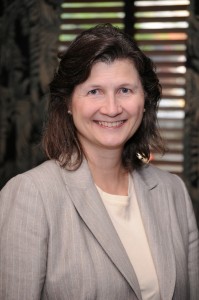By Agnella Izzo Matic, PhD
The breast tumor lights up in pink on the computer screen. Algorithms automatically detect the tumor and predict that this tumor is malignant.
 This scene may soon play out in medical centers around the nation thanks to Dr. Maryellen Giger’s innovative research in the fight against breast cancer. Dr. Giger (rhymes with “tiger”) is Professor and Vice Chair for basic science research in the Department of Radiology, Chair of the Committee on Medical Physics, and Director of the Imaging Research Institute at the University of Chicago.
This scene may soon play out in medical centers around the nation thanks to Dr. Maryellen Giger’s innovative research in the fight against breast cancer. Dr. Giger (rhymes with “tiger”) is Professor and Vice Chair for basic science research in the Department of Radiology, Chair of the Committee on Medical Physics, and Director of the Imaging Research Institute at the University of Chicago.
Dr. Giger’s research focuses on computer-aided diagnosis of breast cancer from multiple breast imaging modalities, including mammography, ultrasound, and MRI (magnetic resonance imaging). The information from Dr. Giger’s computer algorithms can improve breast cancer diagnosis, prognosis, and patient care. For example, in current medical practice, MRI has several uses related to breast cancer. MRI can be used to screen women with a high risk of developing breast cancer or those with dense breasts. MRI is also used as a secondary exam following a suspicious x-ray mammogram, as well as a monitoring method during cancer treatment. Though it is not the gold standard for all breast cancer screening, breast MRI is gaining prominence in medical practice and Dr. Giger’s research is one reason why.
The quantitative image analysis techniques developed by Dr. Giger and her colleagues automatically segment a breast lesion; extract lesion features such as volume, surface area, and contrast kinetics; and estimate the invasiveness of a lesion and the probability of malignancy. Potentially all of this information can aid a radiologist to diagnose cancer, characterize aggressiveness of the tumor, and predict response to therapy.
Several former University of Chicago students formed the company Quantitative Insights to bring Giger’s research to the clinic (Giger sits on the board as a scientific advisor). The company added an intuitive clinical interface to the algorithms and analysis methods developed in Dr. Giger’s lab. Initial feedback for the clinical interface has been overwhelmingly positive and the interface was recently exhibited at the 2012 annual meeting of the Radiological Society of North America (RSNA). Once Quantitative Insights obtains FDA approval for the clinical workstation, radiologists will be able to analyze patients’ breast MRIs using the methods developed at the University of Chicago. Radiologists who have previewed the workstation estimate that they can reduce the time to interpret a breast MRI scan from 30 minutes (using current technology) to 10 minutes. Additionally, the workstation will deliver more in-depth quantitative information to the radiologist than is currently available.
Many organizations have bestowed honors on Dr. Giger. She is a fellow of the American Institute of Medical and Biological Engineers (AIMBE), fellow of the American Association of Physicists in Medicine (AAPM), and member of the National Academy of Engineering, which is arguably the highest professional honor that can be bestowed on an engineer.
And it’s no wonder why. Dr. Giger’s research output is astounding. She has advised over 100 trainees. She has 37 patents issued. She is the author of 177 peer-reviewed manuscripts, and counting. Though these remarkable descriptors all apply to Dr. Giger, they don’t convey the full picture of her intellect, her wisdom, or her warm personality.
Dr. Maryellen Giger appreciates the support she received from several mentors throughout her career. Dr. Rose Carney, Giger’s math professor at Illinois Benedictine College (now Benedictine University), offered Dr. Giger several summer job opportunities during her undergraduate studies. One of those opportunities was a research position working on temperature controls for neutron therapy and building electronics for beam diagnostics at Fermi National Accelerator Laboratory. Dr. Franca Kuchnir, Professor Emerita of Radiation and Cellular Oncology, and the late Dr. Charles Metz, Professor of Radiology, were influential colleagues at the University of Chicago, especially during Giger’s early faculty period.
As a mentor herself, Dr. Giger is pleased to return the favor and give advice gained from her own experience. She is particularly attentive to the needs of junior faculty. Giger is a big proponent of tearing down the hierarchy that is present in academia, noting that in her lab “everyone is equal around the scientific table.” Her hope is that former students and junior colleagues act as a supportive mentor for the next generation of scientists when the time comes.
Outside the laboratory, Dr. Giger spends her down time reading biographies of great scientists and she recently enjoyed “The Emperor of All Maladies” by Siddhartha Mukherjee. Looking forward, the biggest challenge for Giger and her lab is one that almost all biomedical researchers in the US are facing: obtaining funding. Even after a career spanning 4 decades, she still has many ideas for new projects that she would like to begin.
